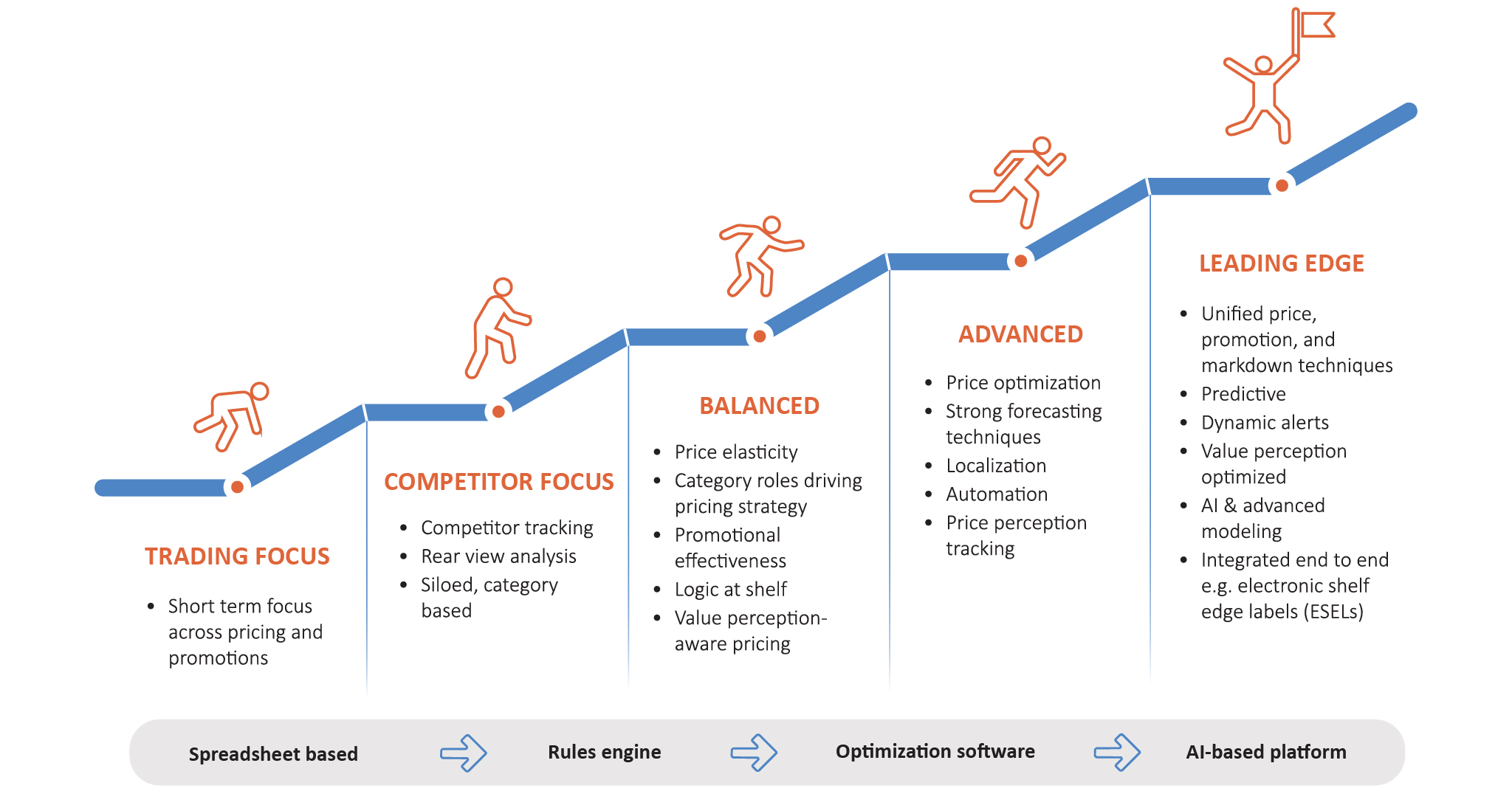Industry
HIGHLIGHTS
- Optimizing prices while balancing profitability, customer perception, and loyalty has been a constant challenge for retailers.
- To navigate the impacts of macroeconomic factors and operational hurdles, retailers are moving from manual ways of working to artificial intelligence (AI) powered price optimization.
- Retailers must go beyond price management and adopt a pricing maturity framework to become price leaders.
On this page
Navigating macroeconomic challenges with pricing strategies
In recent years, retail pricing has faced significant challenges due to inflation, leading to sharp increase in the cost of goods, especially in the grocery sector.
Factors such as supply chain disruptions, escalating production costs, labor shortages, and increased consumer demand have all driven prices upward. At the same time, consumers have become increasingly price sensitive, often seeking discounts, promotions, or moving to alternative brands to manage their pocket amid financial strain.
Retailers have had to navigate the delicate balance of adjusting prices to maintain profitability while striving to remain competitive and retain customer loyalty. This challenging business environment has driven many retailers to adopt data-driven, agile pricing strategies, leveraging advanced analytics and real-time data to make more informed pricing decisions.
We explore common pain points that retailers face in managing pricing and offer a comprehensive framework to establish pricing leadership in these challenging times.
Operational hurdles to price management
For many large-scale retailers, pricing management is a complex and challenging task.
A typical retailer might hold tens of thousands of stock keeping units (SKUs) both online and in stores, in different geographic and demographic zones, leading to a vast number of pricing decisions. The challenge is further intensified by the need for real-time price adjustments to keep pace with changes in costs or competitive pressures.
Often, retailers manage pricing on an as-needed basis. In some cases, retail companies have a small pricing team that is usually confined to operational and tactical activities with less focus on strategic initiatives. As a result, profitability can suffer, and consumer price perception may be negatively affected, potentially leading to a decline in market share and overall sales.
A framework for retail price leadership
A successful pricing program goes beyond price management.
Retailers typically start their pricing journey with limited tools and technology (see Figure 1). For instance, pricing tools may be limited to spreadsheets or outdated legacy systems. At this stage, pricing strategies tend to be less complex and easier to manage. However, as a retailer advances toward more sophisticated pricing strategies, capabilities that can handle complex pricing scenarios become critical. This progression can be achieved by leveraging AI, machine learning (ML), dynamic alerts, localized zoning, forecasting, and other advanced tools and techniques.
To develop a successful pricing program or initiative, retailers must address three major areas: robust pricing strategy, cutting-edge systems and technology, and effective organizational enablers.
Robust pricing strategy
It is crucial for retailers to establish a well-defined pricing strategy. As they advance along the pricing maturity ladder, retailers focus on defining category roles tailored to different localized, geographic, and personalized segments. This approach enables the implementation of customized pricing strategies, such as premium pricing for customers in high-end segments who are willing to pay more for luxury or exclusive products, and discounted pricing for those in price-sensitive segments who seek value deals.
Product segmentation plays a key role, involving the categorization of products based on attributes such as brand, quality, and usage. For example, staple goods or maintenance items might be priced more competitively to drive traffic and increase basket size, while tertiary or specialty items, which are purchased less frequently as an acute need, can command higher prices due to their unique value proposition.
Leading-edge pricing capabilities involve applying an even more granular approach by tailoring strategies to specific customer segments based on demographics, behaviors, and purchasing patterns.
Cutting-edge systems and technology
Implementing an effective pricing strategy requires retailers to adopt robust systems and technology, including AI and ML. The first challenge retailers often face is how quickly they can respond to market shifts and adjust pricing strategies accordingly—a process known as price management that is largely rules based. The second, equally crucial challenge is enhancing price recommendations through price optimization, which leverages consumer demand insights and data science. Let’s discuss how to navigate these challenges.
- Price management: The first step in selecting or building a pricing system is to ensure it includes key capabilities such as setting up pricing rules or guardrails, managing multiple pricing zones, and supporting pricing workflows. Many retailers begin their pricing journey by implementing a rules-based price execution system. This system can apply various rules such as competitive indexing, margin targets, and price-point endings. It can also apply linkage rules such as shade or flavor variations, private vs. national brand distinctions, and size relationships. Additionally, effective price management systems should offer pricing alerts for cost and competitive price changes, workflow approvals, advanced analytics, and the ability to accommodate multiple pricing zones, as well as category roles and objectives.
- Price optimization: Advanced and leading-edge pricing software uses AI and ML techniques to determine the most effective prices that maximize profit and revenue for retailers. This process involves analyzing vast amount of data, including historical sales, market trends, competitor pricing, and consumer behavior, using sophisticated algorithms and ML models. These algorithms employ predictive analytics to forecast demand and price elasticity, enabling retailers to adjust prices in real time as needed. Additionally, clustering and segmentation techniques help identify distinct customer groups, allowing for personalized pricing strategies tailored to specific consumer needs and preferences. By integrating these data-driven insights, retail price optimization supports more informed, science-based pricing decisions.
Leading retailers have adopted advanced solutions that integrate pricing, promotional, and markdown capabilities, positioning them at the forefront of pricing strategy innovation.
Effective organizational enablers
Developing a dedicated organization to manage retail pricing is essential for effective and strategic pricing decisions. Retail organizations must create a specialized pricing team equipped with the necessary analytical skills and tools. This team can support category managers by providing in-depth insights into market trends, competitor pricing, and consumer behavior. Additionally, they can also help develop and implement pricing strategies that align with overall business objectives, optimize profit margins, and enhance customer satisfaction. By continuously monitoring and analyzing pricing performance, the pricing team can make data-driven recommendations and real-time adjustments, helping to maintain competitiveness and respond swiftly to market fluctuations. This structured approach to pricing management will foster cross-functional collaboration, ensure consistency in pricing policies, and ultimately improve profitability.
Agility and innovation for profitable pricing
By leveraging AI in pricing, retailers can optimize business outcomes.
For retailers already operating at capacity, with limited tools and outdated legacy pricing systems, the task of balancing profitability while remaining competitive is a daunting task. By moving away from manual ways of working and adopting leading-edge technologies, retailers can improve customer satisfaction and stay competitive in a rapidly changing market while managing profitability goals. As the retail industry continues to evolve, agility and innovation will be crucial. Retailers must leverage advanced AI-powered price optimization tools to meet the ever-changing demands of consumers, before their competition does.

